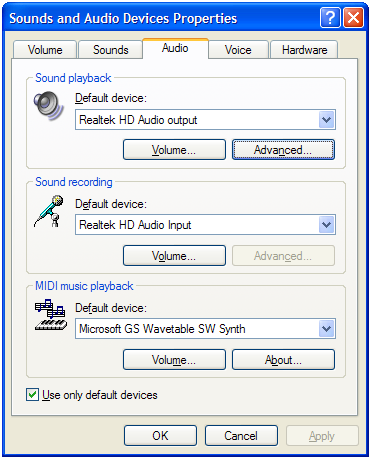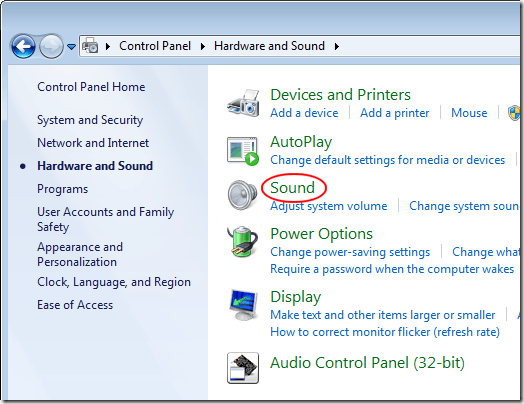Windows Default Sound Device


I downloaded Windows 10, and have sound from the speakers in my computer. However, I want to change the default speakers to my bluetooth speakers, which I. Hi, In my application I need to set programmatically the default sound device (playback device), on XP there is a way changing the HKEY_CURRENT_USER. Learn how to diagnose and fix common sound problems in Windows, including no sound coming from your speakers or headphones. In Windows Sound settings, is it possible to set the default settings for a sound playback device, such as the speaker configuration (7.1 vs Stereo) and the 'Default.
Default Audio Volume Settings (Windows Drivers)The Snd. Vol program (see Sys. Tray and Snd. Vol. The sliders indicate the volume- level settings for the various audio devices and applications such such as speakers and system sounds.

There is an endpoint volume for each audio output and input, and an application volume for each application. The audio driver has control only over its own endpoint volumes, via KSPROPERTY_AUDIO_VOLUMELEVEL. If the driver does not explicitly initialize these volume settings at the time that it is installed, the operating system chooses its own default values for these settings. The defaults that the operating system chooses are not the same across all Windows releases, and vendors might need to take these differences into account to ensure that the volume levels are set neither too high nor too low immediately following driver installation. As a general rule, if the audio adapter drives a set of analog speakers that have their own physical volume control, the INF file should not set the default volume level too low. Otherwise, a user might try to compensate by increasing the volume on the speakers instead of increasing the master volume on the sound card. The result of amplifying a low signal level is loss of audio quality.
If the audio adapter does not have a hardware amplifier, see Software Volume Control Support for information about the software support provided. Note. В В If there is a hardware amplifier, then the driver sets the range and the default level via the KSPROPERTY_AUDIO_VOLUMELEVEL kernel streaming property. If there is not a hardware amplifier, Windows will create a software volume control APO. If there is a physical volume knob on an active set of speakers, it should appear to Windows as a HID control.
Here at Plugable we often hear from customers who have installed their audio device, but no sound is playing through it. Instead, sound may be playing through. Hi, 1. When you say “not able to change the Audio device in the Sound Window”, are you unable to view or change the default audio device in Playback. Fix sound problems. Restart your device and Windows will attempt to reinstall the driver. the Default Device and select Properties. Sound Device is located in the Components category in System Information. It contains information about the sound devices on your system, including the name.
This will function similarly to the volume up and volume down buttons on a keyboard; Windows will see the volume knob turn and will program the volume control correspondingly (whether it is a hardware or software volume.). В Ideally, if a set of active speakers ships in the same box with the audio adapter card, the factory should adjust the volume knob on the speakers to the position that works best with the adapter's default volume setting. If the audio adapter does not have a physical volume control knob, see the Software Volume Control Support topic for information about the software support provided by Windows. Note. В В If the audio hardware exposes a hardware volume control (like a volume knob), then the driver sets the range and the default level via the KSPROPERTY_AUDIO_VOLUMELEVEL Kernel Streaming property. В The following table shows the volume ranges and default volume levels for audio in the different versions of Windows.
Windows version. Microphone default values. Non- microphone* default values. Windows Vista SP1. Default level: 0. Volume Range : - 1. B ~ +1. 2. 0d. BDefault level: 0.
Default Audio Volume Settings. by increasing the volume on the speakers instead of increasing the master volume on the sound card. Windows 7: Default level.
Volume Range : - 1. B ~ 0d. BWindows. В 7. Default level: +3. BVolume Range : - 1. B ~ +3. 0. 0 d. BDefault level: 0 d. BVolume Range : - 1.
B ~ 0 d. BWindows. В 8. Default level: 0. BVolume Range: - 9. B ~ +3. 0 d. BDefault level: 0. BVolume Range: - 9. B ~ 0 d. BВ *The term non- microphone describes all playback devices and recording devices other than microphones. For information about the operational characteristics of the physical volume sliders that are represented by the software volume sliders in Windows applications, see Audio- Tapered Volume Controls.
Related topics. Customizing Default Audio Volume Settings. В В Send comments about this topic to Microsoft.
Set Default Sound Device in Windows. Here at Plugable we often hear from customers who have installed their audio device, but no sound is playing through it. Instead, sound may be playing through the computer’s built- in speakers or not at all. This blog post explains how to set your audio device as the default device that Windows uses for audio output. In the first section we will explain how to set this for USB devices like Pluguble docking stations, sound- enabled display adapters, and the Plugable USB audio adapter.
In the second section, we will explain this for audio devices like headphones or speakers that are connected through devices like the Plugable Bluetooth adapter. All the same steps would apply to any non- Plugable USB or Bluetooth audio device, so even if you don’t have a Plugable product this should be helpful background. USB Devices. 1. Make sure everything is connected correctly and drivers are installed. Right- click on the speaker symbol in the system tray, and select Playback Devices.
The Sound window will open with the Playback tab highlighted. Find your device in the window. A Plugable USB 3. Plugable Audio. A Plugable USB 2. USB Multimedia Audio Device. A Plugable USB Audio adapter will appear as USB Audio Device.
Right- click on the device you found in step 3 and select Set as Default Device. A check mark should appear next to your device, and sound should now play through it. Click OK to exit the window. Bluetooth. 1. Connect your device by making it discoverable (see its owners manual), click the Bluetooth icon in the system tray, then click Add a Bluetooth Device.
Your device should appear in the Manage Bluetooth Devices window. Click the device and select Pair. After the device drivers are installed (your device may beep or vibrate), right- click the speaker symbol in the system tray and select Playback Devices.
Your device will appear on the list under the same name as when you paired it. If it appears as a Headset and Headphones, select Headphones for the best sound. Speakers will also appear as headphones or a headset. Right- click the device and select Set as Default Device. You can also select Set as Default Communication Device to use this device for communication programs like Skype.
You can set Headphones for music and Headset for communications if these are available. Click OK to exit the Window. We hope this guide makes it easier to use your Plugable audio devices. If you have any questions, please comment below or contact us at support@plugable.